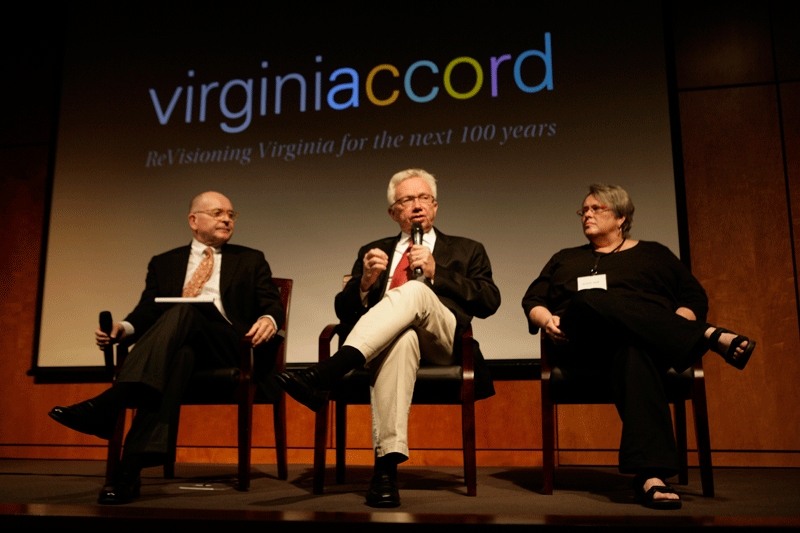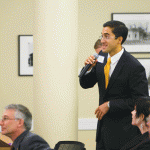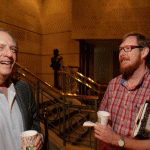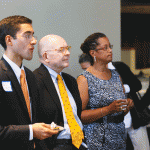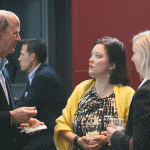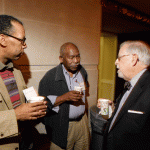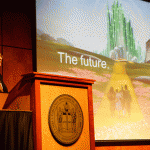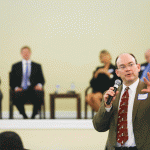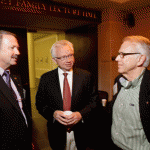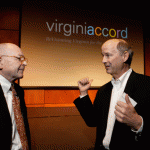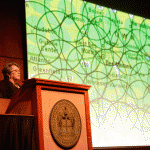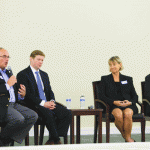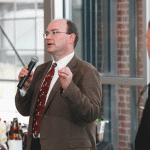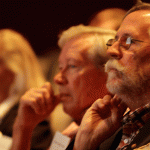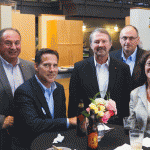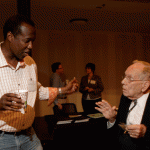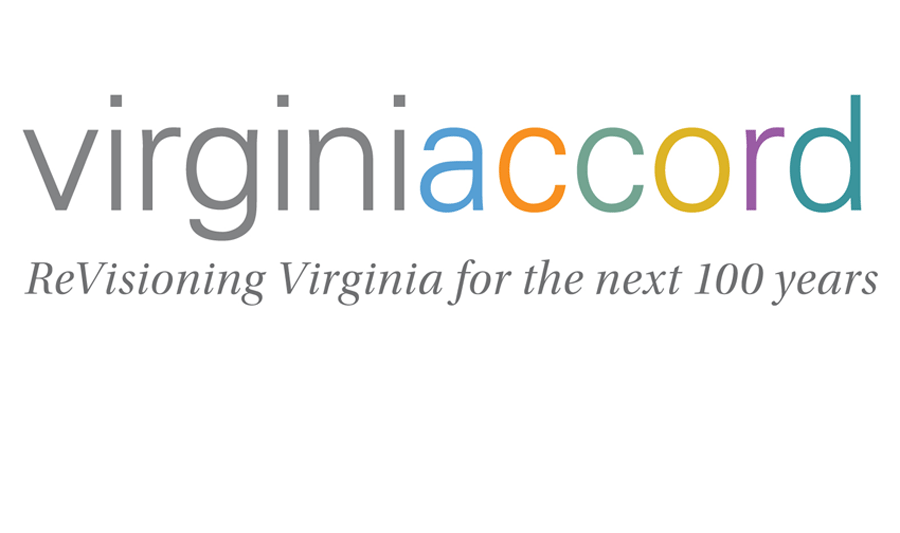By William Evans
What do migrating Millennials, walking the dog, obesity, transit corridors and urban design have in common?
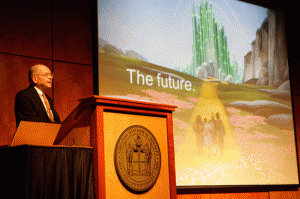 According to a host of speakers, politicians, health experts, landscape architects, environmentalists and academics, the same instinct driving a reverse migration back to urban centers is one key to enable the country to rebuild our communities in healthier, more energy efficient ways, move past its fossil fuel addiction, and help reverse the effects of climate change. It was a packed two days.
According to a host of speakers, politicians, health experts, landscape architects, environmentalists and academics, the same instinct driving a reverse migration back to urban centers is one key to enable the country to rebuild our communities in healthier, more energy efficient ways, move past its fossil fuel addiction, and help reverse the effects of climate change. It was a packed two days.
The Virginia Accord symposium was held in celebration of 100 years of the AIA in Virginia and in expectation of the next 100. The audience assembled in the newly renovated Virginia Historical Society to hear from William Euille, Mayor of Alexandra and Mary Hynes, Arlington County Board Member on what their two communities are building together. Investments in infrastructure are often unpopular, particularly ones with long time lines and big price tags. Yet often both leaders argued that these investments are the needed catalysts. The story of Arlington’s decades’ long commitment to transit-oriented development makes the economic case for strategic investments in infrastructure. Alexandria’s focus on energy efficient buildings, public and private alike and a holistic approach to sustainability point to how that community is facing the future.
With the current legislative impasse at the national level, it is the work of local mayors and councils, county boards and local leaders that are filling that leadership vacuum. Euille stated it bluntly: extreme weather costs, carbon pollution costs, and climate change may bring the largest cost of all. After Hurricane Sandy, New York City is beginning to get it the same way Norfolk does, already facing the rising waters lapping at historic properties there.
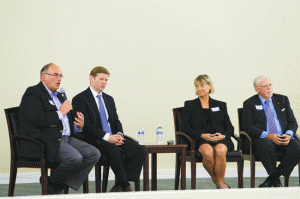 Kim Tanzer, former School of Architecture Dean at UVA focused her talk on how research is both viewed and practiced in the profession. Unlike other professions, architects seek practical applications over basic research―not surprising given the material world we practice in ― but “is it possible to envision another form of research, native to designers, to supplant the 19th century research paradigms we have inherited?” And are those paradigms sufficient to the present day?
Kim Tanzer, former School of Architecture Dean at UVA focused her talk on how research is both viewed and practiced in the profession. Unlike other professions, architects seek practical applications over basic research―not surprising given the material world we practice in ― but “is it possible to envision another form of research, native to designers, to supplant the 19th century research paradigms we have inherited?” And are those paradigms sufficient to the present day?
“Many recognize that to create a better world, we must incorporate systematic learning into our practices. How can we better learn from our mistakes, individually and as a profession? How can we improve our work, incrementally project by project? How might architects generate compelling questions to drive our designs forward, utilizing projects, sites, and building types as both a means of inquiry and a satisfying end?” One growing trend in the profession is architects beginning practice to expend significant energies studying uncommon materials and borrowings from other industries as means to different ends. Does this herald a new generation of inventors? A new profession? Though it may be too soon to tell, the idea is intriguing.
Dr. Jason Hartke, VP, US Green Building Council reminded his audience that the environmental movement has been ongoing for several generations and it’s now or never. “With over $1 trillion infrastructure estimated needs not funded,” we have no time to waste. Quoting William McDonough, “Progress has been made, but if you’re driving 60 heading toward a wall, slowing down to 30 won’t cut it.” Within a remarkably short period of time, USGBC’s LEED system has changed the conversation. By becoming its own “institution” however, the greater responsibility lies in the future. What we chose today will influence future generations. In Hartke’s world view, inclusivity is key. “Go fast; go alone. Go long; go together. Green building is a ground up process.” Global policy is not the way; local decisions need to be how we move forward.
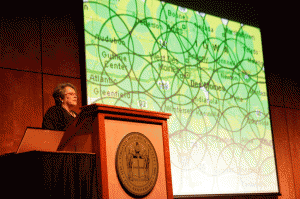 Dr. Jackson framed the argument with facts. For him what had begun as antidotal observations while at the CDC in Atlanta can now be backed up by facts: there is a quantifiable relationship between chronic disease and how communities in this country have been developed since World War II. Obesity, diabetes, asthma and organ diseases can be statistically linked to the car-centric lifestyle most of us live, and a key component lies in our built environment. With no thought of how one might navigate through spaces that are psychologically hostile if not life-threatening to pedestrians, we need to reframe the rules. Tysons Corner in Fairfax County is a prime example. “Atlanta is same size as Barcelona but 20 times more spread out” gives the measure of the misallocation of space. The acreage devoted to cars – roads, parking lots is staggering. One recent study quoted in the NY Times estimated that “we’ve built eight parking spots for every car in the country. Houston is said to have 30 parking spaces per resident.” By contrast “New York’s High Line is tenth most popular tourist destination in the U.S” confirms a basic tenant about how people want to live in urban areas.
Dr. Jackson framed the argument with facts. For him what had begun as antidotal observations while at the CDC in Atlanta can now be backed up by facts: there is a quantifiable relationship between chronic disease and how communities in this country have been developed since World War II. Obesity, diabetes, asthma and organ diseases can be statistically linked to the car-centric lifestyle most of us live, and a key component lies in our built environment. With no thought of how one might navigate through spaces that are psychologically hostile if not life-threatening to pedestrians, we need to reframe the rules. Tysons Corner in Fairfax County is a prime example. “Atlanta is same size as Barcelona but 20 times more spread out” gives the measure of the misallocation of space. The acreage devoted to cars – roads, parking lots is staggering. One recent study quoted in the NY Times estimated that “we’ve built eight parking spots for every car in the country. Houston is said to have 30 parking spaces per resident.” By contrast “New York’s High Line is tenth most popular tourist destination in the U.S” confirms a basic tenant about how people want to live in urban areas.
Speaking directly to the Accord, Dr. Jackson pointed out that the fifth highest risk to workers’ health is unemployment, a droll if sad comment on the Great Recession.
Livable communities have been a polite AIA objective for some time, though Jackson put it more imperatively, designing healthy communities is what’s important, and more optimistically, if we design them, Millennials will come. For forty to fifty years what has been wistfully talked about in design circles has become what Millennials expect in their natural environment. “Master Plans should have health impacts discussed. Decisions without considering health impacts has huge implications for long term good health.” And in a final plea for a better life, “All rivers and streams should be walkable.”
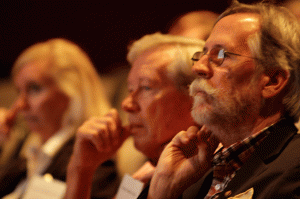 Jim Cramer put the case for forward thinking in the architectural profession, in his words “why there is a bright future for architects.” Using his firm’s research published in Design Intelligence he discussed the fresh opportunities and expanding markets for architects. “Unless we evolve, the profession could be bypassed.” How does an architect achieve a resilient and purposeful outlook and action plan? How does one find the best synthesis of site, program and design? Two sides of the same coin, ones which architects face every day in practice. Different day, same stack of competing demands needing to be balanced. Cramer’s central point was that “Strategic renewal is possible,” and that productivity is “going up like a rocket.” As usual some may be faster to the dance, but even though change is inevitable, the means to address its challenges should feel like old friends to a practicing architect.
Jim Cramer put the case for forward thinking in the architectural profession, in his words “why there is a bright future for architects.” Using his firm’s research published in Design Intelligence he discussed the fresh opportunities and expanding markets for architects. “Unless we evolve, the profession could be bypassed.” How does an architect achieve a resilient and purposeful outlook and action plan? How does one find the best synthesis of site, program and design? Two sides of the same coin, ones which architects face every day in practice. Different day, same stack of competing demands needing to be balanced. Cramer’s central point was that “Strategic renewal is possible,” and that productivity is “going up like a rocket.” As usual some may be faster to the dance, but even though change is inevitable, the means to address its challenges should feel like old friends to a practicing architect.
Kennedy Smith, with Community Land Use and Economics Group, torpedoed ‘the way we were’ making effective use of photographs showing Kentucky Fried logos and golden arches spanning strip malls have homogenized the country. “Over a generation we have created a drive thru culture, based on Euclidian (single-use) zoning” After decades of speculative building that’s left an imprint of asphalt and overbuilt and decaying commercial strips, what she proposes is a bit like a renaissance. She left the audience with hope in a future made by local people investing in their communities the old fashioned way ― looking for long term growth not necessarily just quarterly stock reports.
Principles of the Virginia Accord:
Responsible Job Creation; where government officials, philanthropic leaders and private enterprise reflect a deeply caring attitude and knowledge on how to build a thriving, growing economy — one that welcomes business and entrepreneurship that protects our natural environment.
Constructed Environment that includes residential, commercial and industrial, accounts for 31% of all energy consumed in the USA. Architects and other building professionals must commit to educate, plan, design and construct energy efficient and environmentally sustainable structures that contribute to the well being of life, not its erosion.
Public Health is critical to those engaged in creating our constructed landscape. We cannot ignore the negative public health trends becoming increasingly evident in our State, with particular note to asthma and obesity. Both challenge our children and their life expectancy and ability to contribute to society when they become adults.
Transportation accounts for 27% of all energy consumed in the USA. Its issues are not irrelevant to our natural and built environment concerns. Our professionals know that forms of mass transit can save Virginia cities and landscapes while stimulating job growth and reducing environmental impact and energy use.
Land Development and Urban Infill affects people where they live, work and recreate. Our city cores can be viable centers of energy that combine mixed-use opportunities for sustainable walk able foci of work, living and playing.
You can still add your name to show support for these principles.

